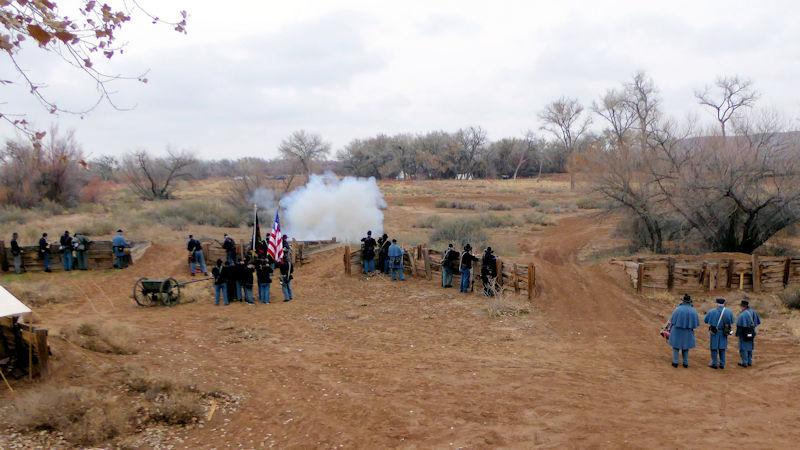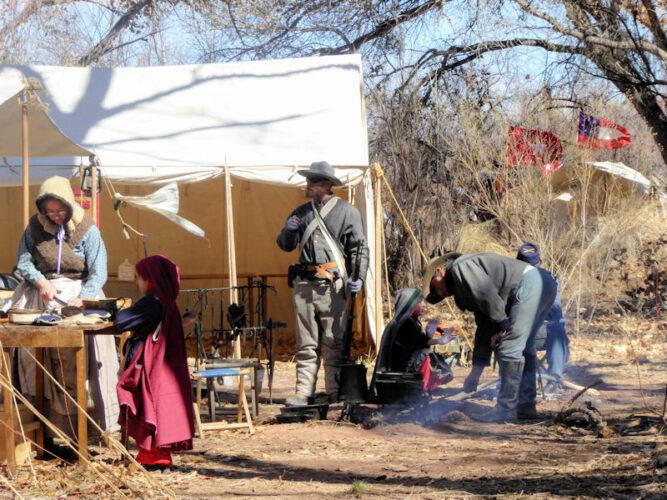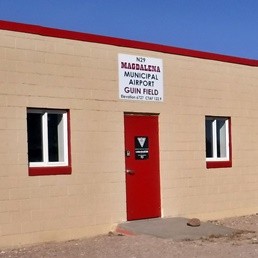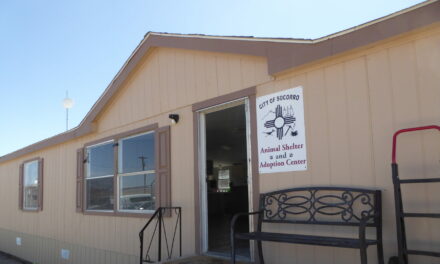
The Union army prepares for an assault on their position by Rebel forces with cannon fire at the last reenactment of the Battle of Valverde in 2020.
John Larson | El Defensor Chieftain photos
This Saturday and Sunday, Feb. 19-20, dozens of Civil War reenactors will turn back the clock as Confederate soldiers attack New Mexico’s Union volunteers in the 22nd annual Battle for Socorro. The event, held on the banks of the Rio Grande at the Escondida Bridge, commemorates New Mexico’s early involvement in the War Between the States, a brief but important period of the Confederate Army’s attempt to control the Southwest.
Organizer Gabriel Peterman said he expects over 50 reenactors to take part.
“All our reenactors utilize either original or period-correct reproductions of the firearms. They’re usually 58 to 69 caliber muskets,” he said. “There might be a smattering of breech loaders mixed in, but those were very rare in this campaign.”
According to Peterman, in 1862, Confederate forces might also be carrying hunting rifles or black powder shotguns because Sibley’s troops were very poorly equipped when beginning the New Mexico campaign.
“Confederate Brigadier General Henry Hopkins Sibley’s troops were asked to bring their own horses, and their own firearms because his forces had a very limited amount of supplies available to him when he started marching into New Mexico,” he said. “One of the great examples from the Battle of Valverde is there was a Confederate unit that actually captured an artillery battery and they were armed with shotguns. That’s probably the only time in history where a group with shotguns captured an artillery battery.”

The period Confederate encampment is open to visitors.
In 1862 Socorro County extended from Texas to California and the Confederates hoped to capture the Southwest including New Mexico, the goldfields of Colorado, and all the way to the California coast.
Sibley’s first step was to gather an army in El Paso, Texas, with the objective of capturing Fort Craig.
“You had Texans who were tradesmen, cowboys, lawyers, some very educated people who came with them,” he said. “And they were all united in the thought that this was going to be an easy campaign and that New Mexico was going to be a fast victory and they were going to be able to push all the way into Colorado. Of course, that didn’t pan out.”
On Feb. 16, 1862, the Confederate 5th Regiment of Texas Mounted Volunteers formed a battle line and headed for Fort Craig, south of Socorro, which was garrisoned eight years earlier to protect settlers and homesteaders from Apache raids. The Union army’s Col. Edward Canby stationed a battery of guns and howitzers outside the south-facing walls of Fort Craig. Seeing this, the Confederates then called off the attack and withdrew.
Three days later the Confederates moved north to control the ford on the Rio Grande at the town of Valverde, driving the Union soldiers back to Fort Craig to meet them.
The next day, Feb. 21, 1862, the two armies clashed near the river. The Battle of Valverde ended in a tactical victory for the Confederacy, but Sibley’s forces failed to capture Fort Craig.
After breaking camp two days later the Confederate 5th Texas Mounted Rifles easily defeated the Union’s 2nd New Mexico Militia stationed in Socorro.
The capture of Albuquerque and Santa Fe followed. But Confederate forces lost steam after losing a battle at Glorieta Pass, southeast of Santa Fe, so Sibley decided to take his Confederate troops back to Texas on a roundabout route. Worn out and short on supplies and ammunition, Sibley’s army veered west at the Ladrones and then south, passing between the Magdalena and San Mateo mountain ranges in order to avoid getting too close to Fort Craig.
Confederate uniform buttons and other artifacts have been discovered along that route, specifically in the area of Pueblo Springs, north of Magdalena.
Peterman said he hopes the annual event inspires more interest in Socorro’s diverse history.
“One of our goals is to try to expand their living history, beyond the Civil War re-enactment,” he said.
Many present-day Socorro families are descendants of those who fought the Rebels as part of the New Mexico militia.
“Both the city and county have a unique place in Civil War history,” Peterman said. “We’ll be doing a lot of maneuvering out in the field.”
Volunteers have been busy preparing the battlefield area and the redoubt on the Rio Grande at Escondida Bridge. The wooded area east of the battlefield gives re-enactors more options, especially with cannon fire and cavalry charges.
“We’re looking at having three artillery pieces on the Confederate side, and two on the Union side, out there firing during the reenactment,” Peterman said. “Saturday we’ll be doing battle reenactments that will include vignettes out of the Battle of Valverde. One of the things that sets the Battle of Valverde apart from every other battle in the Civil War was a lancer charge. Some of the Texas mounted units actually charged the United States forces with spears. In fact, the last lancer charge in American history was at Valverde.”
Peterman, a Major in the New Mexico National Guard, has been involved with reenactments for about 17 years and holds a master’s degree in history from New Mexico State University.
“One of my great-great-great-grandfathers was an officer in the 17th United States Colored Infantry during the Petersburg Campaign,” Peterman said. “It was one of the first Black regiments in the US Army and he was one of the officers who volunteered to go ahead and work with them, knowing full well that if the Confederates caught him he would’ve been executed for leading African Americans.”
The encampment on the north side of the Escondida Bridge opens to the public Saturday morning and the battles are performed both on Saturday and Sunday.
“It’s no cost to them to come and learn a little bit about their history,” Peterman said. “My kids are always there, too.”
Saturday, Feb. 19
Camps open to public – 9 a.m.
Reenactor drill
Commander’s meeting – 10 a.m.
Battle of Valverde – 11 a.m.
Special exhibits in camps throughout the day
Sunday, Feb. 20
Fort Escondida
Camps open to public – 9 a.m.
Commanders Choice Tactical Battle – 11 a.m.
A variety of presentations with display materials will take place.


















